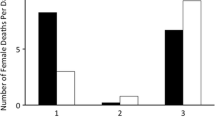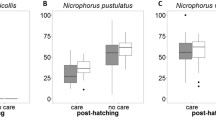Summary
Single females and pairs of Nicrophorus orbicollis Say were established as residents on carcasses to investigate interactions with intruders under natural conditions. When carcasses were exhumed 10–12 days later, one or more intruders were found on 19% of nests. Intruders expelled one or both of the residents and sometimes paired with a resident or another intruder of the opposite sex. An intruder tended to be larger than the same-sex adult it replaced on a carcass. A male intruder that joined a single female, on the other hand, was not necessarily larger than the resident female. There was indirect evident that intruders committed infanticide and then started their own reproductive attempt on the carcass. Follow-up experiments in the laboratory indicated that interactions between intruders and residents were agonistic and that infanticide regularly occurred as a consequence of a takeover. Use of a genetic marker demonstrated that male and female intruders obtained reproductive benefits from infanticide. However, intruders sometimes cared for mixed broods consisting of their own young and young of a prior resident.
Similar content being viewed by others
References
Bartlett J (1988) Male mating success and parental care in Nicrophorus vespilloides (Coleoptera: Silphidae). Behav Ecol Sociobiol 23:297–303
Bartlett J, Ashworth CM (1988) Brood size and fitness in Nicrophorus vespilloides (Coleoptera: Silphidae). Behav Ecol Sociobiol 22:429–434
Brooks RJ (1984) Causes and consequences of infanticide in populations of rodents. In: Hrdy SB, Hausfater G (eds) Infanticide: comparative and evolutionary perspectives. Aldine, New York, pp 331–348
Freed LA (1986) Territory takeover and sexually selected infanticide in tropical house wrens. Behav Ecol Sociobiol 19:197–206
Hayssen VD (1984) Mammalian reproduction: constraints on the evolution of infanticide. In: Hrdy SB, Hausfater G (eds) Infanticide: comparative and evolutionary perspectives. Aldine, New York, pp 105–124
Hrdy SB (1974) Male-male competition and infanticide among the langurs (Presbytis entellum) of Abu, Rajasthan. Folia Primatologica 22:19–58
Hrdy SB (1977) The Langurs of Abu: female and male strategies of reproduction. Harvard University Press, Cambridge MA
Hrdy SB (1979) Infanticide among animals: a review, classification, and examination of the implications for the reproductive strategies of females. Ethol Sociobiol 1:13–40
Hrdy SB, Hausfater G (eds) (1984a) Infanticide: comparative and evolutionary perspectives. Aldine, New York
Hrdy SB, Hausfater G (1984b) Comparative and evolutionary perspectives on infanticide: introduction and overview. In: Hrdy SB, Hausfater G (eds) Infanticide: comparative and evolutionary perspectives. Aldine, New York, pp xiii-xxxv
Leyland L, Struthsaker TT, Butynski TM (1984) Infanticide by adult males in three primate species of Kibale Forest, Uganda: a test of hypotheses. In: Hrdy SB, Hausfater G (eds) Infanticide: comparative and evolutionary perspectives. Aldine, New York, pp 151–172
Linsenmair KE (1987) Kin recognition in subsocial arthropods, in particular in the desert isopod Hemilepistus reaumuri. In: Fletcher DJC, Michener CD (eds) Kin recognition in animals. Wiley, Chichester, pp 121–208
Milne LJ, Milne M (1976) The social behavior of burying beetles. Sci Am 235:84–89
Mock DW (1984) Infanticide, siblicide, and avian nestling mortality. In: Hrdy SB, Hausfater G (eds) Infanticide: comparative and evolutionary perspectives. Aldine, New York, pp 2–30
Müller JK (1987) Replacement of a lost clutch: a strategy for optimal resource utilization in Necrophorus vespilloides (Coleoptera: Silphidae). Ethology 76:74–80
Müller JK, Eggert A-K (1987) Effects of carrion-independent pheromone emission by male burying beetles (Silphidae: Necrophorus). Ethology 76:297–304
Müller JK, Eggert A-K (1989) Paternity assurance by “helpful” males: adaptations to sperm competition in burying beetles. Behav Ecol Sociobiol 24:245–249
Müller JK, Eggert A-K, Dressel J (1990) Intraspecific brood parasitism in the burying beetle, Necrophorus vespilloides (Coleoptera: Silphidae). Anim Behav 38 (in press)
Mumme RL, Koenig WD, Pitelka FA (1983) Reproductive competition in the communal acorn woodpecker: Sisters destroy each other's eggs. Nature 306:583–584
Packer C, Pusey AE (1984) Infanticide in carnivores. In: Hrdy SB, Hausfater G (eds) Infanticide: comparative and evolutionary perspectives. Aldine, New York, pp 31–42
Pardi L (1948) Dominance order in Polistes wasps. Phys Zool 21:1–13
Polis GA (1984) Intraspecific predation and ⌜nfant killing” among invertebrates. In: Hrdy SB, Hausfater G (eds) Infanticide: comparative and evolutionary perspectives. Aldine, New York, pp 65–86
Pukowski E (1933) Ökologische Untersuchungen an Necrophorus F. Z Morphol Okol Tiere 27:518–586
Scott MP (1989) Male parental care and reproductive success in the burying beetle, Nicrophorus orbicollis. J Insect Behav 2:133–137
Scott MP (1990) Brood guarding and the evolution of male parental care in burying beetles. Behav Ecol Sociobiol 26:31–39
Scott MP, Traniello JFA (1987) Behavioural cues trigger ovarian development in the burying beetle, Nicrophorus tomentosus. J Insect Phys 33:693–696
Scott MP, Traniello JFA (1989) Guardians of the underworld. Natural History, June, pp 32–37
Scott MP, Traniello JFA (1990) Behavioural and ecological correlates of male and female parental care and reproductive success in burying beetles (Nicrophorus spp.). Anim Behav 39:274–283
Stephens ML (1982) Mate takeover and possible infanticide by a female northern jacana (Jacana spinosa). Anim Behav 30:1253–1254
Trumbo ST (1987) The ecology of parental care in burying beetles (Silphidae: Nicrophorus). PhD thesis, University of North Carolina, Chapel Hill
Trumbo ST (1990) Interference competition among burying beetles (Silphidae: Nicrophorus). Ecol Entomol (in press)
Whitmore MJ (1986) Infanticide of nestling noisy miners, communally breeding honeyeaters. Anim Behav 34:933–935
Wilson DS, Fudge J (1984) Burying beetles: intraspecific interactions and reproductive success in the field. Ecol Entomol 9:195–203
Wilson DS, Knollenberg WG (1984) Food discrimination and ovarian development in burying beetles (Coleoptera: Silphidae: Nicrophorus). Ann Entomol Soc Am 77:165–170
Wilson DS, Knollenberg WG, Fudge J (1984) Species packing and temperature dependent competition among burying beetles (Silphidae, Nicrophorus). Ecol Entomol 9:205–216
Wilson EO (1971) The insect societies. Harvard University Press, Cambridge MA
Wilson EO (1975) Sociobiology: the new synthesis. Harvard University Press, Cambridge MA
Author information
Authors and Affiliations
Rights and permissions
About this article
Cite this article
Trumbo, S.T. Reproductive benefits of infanticide in a biparental burying beetle Nicrophorus orbicollis . Behav Ecol Sociobiol 27, 269–273 (1990). https://doi.org/10.1007/BF00164899
Received:
Revised:
Issue Date:
DOI: https://doi.org/10.1007/BF00164899




